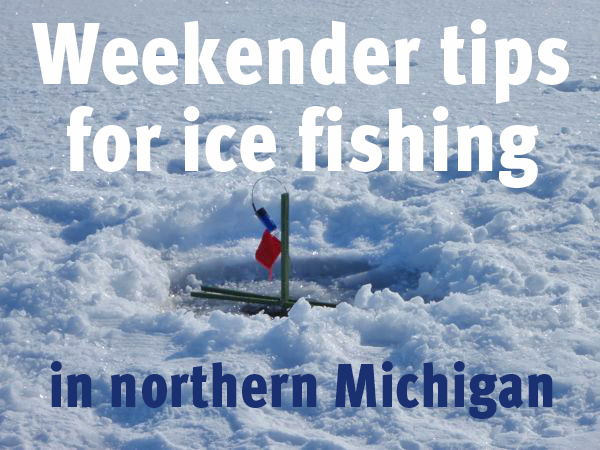Weekender Tips for Ice Fishing in Northern Michigan
A holiday weekend is the perfect time to enjoy one of northern Michigan’s favorite outdoor activities: ice fishing. And it’s not just locals who are itchin’ to go fishin’. Visitors come from miles around to catch their limit on our frozen lakes.
Here are a few tips from a local for the casual weekender who wants to give ice fishing a try —from advice on equipment, to safety and a fish finder for area lakes. These tips won’t guarantee a prosperous catch, but they’ll set you up for a fun, safe angling adventure on Michigan’s frozen playgrounds.
Licensed to Catch
The first thing every angler needs is a license. And the MDNR offers several options.
- You can now buy an e-license online anytime at mdnr-elicense.com.
- There are three licensing options: one-day license, season license and a new 72-hour all species license. The last option is great for the weekender as it’s available to residents and non-residents for $30.
- Fish for free on one of Michigan’s free fishing weekends. Mark you calendars for February 14-15, 2015 for this winter’s free weekend.
Equipment
Here’s a list of the basic equipment and supplies you’d need for an afternoon out on the ice. And like most sports and hobbies, there are the necessities, and then there are thousands of variations, and upgrades that can expand the options, and empty your wallet. These are the nuts and bolts. You take it where you want to from here.
- Valid Michigan fishing license, see above. Children under 17 can fish for free;
- Ice Auger or spud, depending on the depth of the ice. More than four inches of ice and you’ll probably want an auger;
- Sled to pull your gear, depending on how much you have;
- Portable shanty, foldable chair or bucket to sit on;
- Tip-ups or ice fishing rods;
- Bait: for tip-ups use minnows like golden shiners or blues. For rods use wax worms or artificial bait like jigs and spoons.
Tip: Don’t forget to keep the receipt from the bait shop if you buy live bait, like minnows. Live bait must be certified to prevent the spread of disease. DNRE officers may ask for proof of purchase.
Safety Tips
- Safe ice is thick ice. Four inches is recommended for safely fishing on Michigan’s inland lakes. If you’re heading out with a snowmobile or ATV, err on the side of caution and wait for 5″-6″ of ice.
- Watch for holes, cracks and open ice. Freshly abandoned ice fishing holes are a quick way to twist an ankle or worse. Anglers often leave branches or markers in their abandoned ice holes as a warning, so keep your eyes open.
- Bring emergency gear. Safety spikes are a great solution, and can be worn around the neck. They look like a short jump-rope with handles on the end, each equipped with a spike. If you fell in the ice you could use the picks to pull you out. A lifejacket and some rope are a good back-up plan.
- Don’t fish alone. It’s not as much fun anyway, so bring a buddy.
Tip: If you’re unsure about the safety of lake ice, get some advice from the bait shop or a local. Many small inland lakes are not ideal for ice fishing because they’re spring fed. The way the ice forms can also determine whether it’s strong enough to support additional weight. So if you don’t see any tracks, or evidence of activity on the surface, don’t venture out, especially alone.
 Fish Finder
Fish Finder
There are dozen of lakes in northwestern Michigan that could be great for fishing. And certain species thrive in specific lakes. Here’s a short guide to some of the most popular species, and where you can find them.
- If your fishing for pike check out Portage Lake in Onekema and Green Lake in Interlochen;
- For smelt try Crystal Lake in Benzie county, and Green Lake;
- For perch Crystal Lake and Glen Lake near Glen Arbor;
- For walleye visit Long Lake in Traverse City, and Lake Leelanau on the Leelanau Peninsula.
Tip: Know your limit, and stay within it. The DNRE limits the catch on each species, and limits vary. Check out the MDNR website for all the details.



